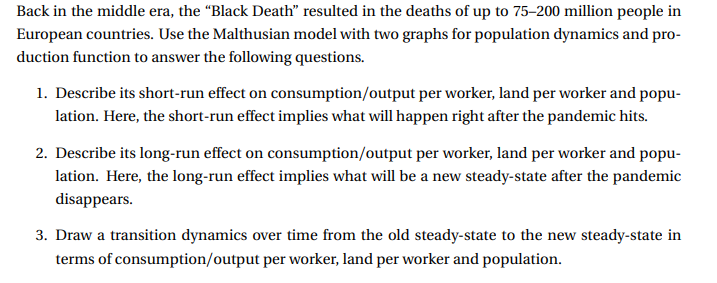nction to answer the following questions. ribe its short-run effect on consumption/output per worker, land per worker and popu- 1. Here, the short-run effect implies what will happen right after the pandemic hits. ribe its long-run effect on consumption/output per worker, land per worker and popu- 1. Here, the long-run effect implies what will be a new steady-state after the pandemic ppears. a transition dynamics over time from the old steady-state to the new steady-state in
nction to answer the following questions. ribe its short-run effect on consumption/output per worker, land per worker and popu- 1. Here, the short-run effect implies what will happen right after the pandemic hits. ribe its long-run effect on consumption/output per worker, land per worker and popu- 1. Here, the long-run effect implies what will be a new steady-state after the pandemic ppears. a transition dynamics over time from the old steady-state to the new steady-state in
Chapter1: Making Economics Decisions
Section: Chapter Questions
Problem 1QTC
Related questions
Question

Transcribed Image Text:Back in the middle era, the “Black Death" resulted in the deaths of up to 75–200 million people in
European countries. Use the Malthusian model with two graphs for population dynamics and pro-
duction function to answer the following questions.
1. Describe its short-run effect on consumption/output per worker, land per worker and popu-
lation. Here, the short-run effect implies what will happen right after the pandemic hits.
2. Describe its long-run effect on consumption/output per worker, land per worker and popu-
lation. Here, the long-run effect implies what will be a new steady-state after the pandemic
disappears.
3. Draw a transition dynamics over time from the old steady-state to the new steady-state in
terms of consumption/output per worker, land per worker and population.
Expert Solution
This question has been solved!
Explore an expertly crafted, step-by-step solution for a thorough understanding of key concepts.
Step by step
Solved in 3 steps with 1 images

Knowledge Booster
Learn more about
Need a deep-dive on the concept behind this application? Look no further. Learn more about this topic, economics and related others by exploring similar questions and additional content below.Recommended textbooks for you


Principles of Economics (12th Edition)
Economics
ISBN:
9780134078779
Author:
Karl E. Case, Ray C. Fair, Sharon E. Oster
Publisher:
PEARSON

Engineering Economy (17th Edition)
Economics
ISBN:
9780134870069
Author:
William G. Sullivan, Elin M. Wicks, C. Patrick Koelling
Publisher:
PEARSON


Principles of Economics (12th Edition)
Economics
ISBN:
9780134078779
Author:
Karl E. Case, Ray C. Fair, Sharon E. Oster
Publisher:
PEARSON

Engineering Economy (17th Edition)
Economics
ISBN:
9780134870069
Author:
William G. Sullivan, Elin M. Wicks, C. Patrick Koelling
Publisher:
PEARSON

Principles of Economics (MindTap Course List)
Economics
ISBN:
9781305585126
Author:
N. Gregory Mankiw
Publisher:
Cengage Learning

Managerial Economics: A Problem Solving Approach
Economics
ISBN:
9781337106665
Author:
Luke M. Froeb, Brian T. McCann, Michael R. Ward, Mike Shor
Publisher:
Cengage Learning

Managerial Economics & Business Strategy (Mcgraw-…
Economics
ISBN:
9781259290619
Author:
Michael Baye, Jeff Prince
Publisher:
McGraw-Hill Education